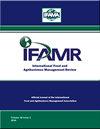挪威远洋渔业管理与挪威海产品理事会出口促进的明显冲突
IF 1.5
4区 经济学
Q3 AGRICULTURAL ECONOMICS & POLICY
International Food and Agribusiness Management Review
Pub Date : 2022-02-25
DOI:10.22434/ifamr2021.0059
引用次数: 0
摘要
挪威政府实行远洋渔业管理制度,旨在避免过度捕捞和促进可持续的年度捕捞,同时管理一项出口促进计划,旨在增加鲱鱼和鲭鱼的对外销售。同时促进远洋鱼类的国外销售和限制这些鱼类供销售是明显冲突的政策。然而,这项研究表明,对用于出口的远洋鱼类的有效限制往往有助于实现挪威海产品理事会(NSC)为挪威鲱鱼和鲭鱼产业制定的提高利润的出口促进目标。假设在2003年至2018年的分析期间,由于各自的渔业管理制度,鲱鱼和鲭鱼的出口受到高度(但不是完全)有效的限制,那么NSC鲱鱼和鲭鱼出口促进对挪威鲱鱼出口收入和行业利润的贡献分别为5-7%,对挪威鲭鱼出口收入和行业利润的贡献分别为11-15%。对挪威鲱鱼和鲭鱼出口供应的限制效果较差,将削弱促进国家安全委员会出口所带来的各自行业收入和利润。从本质上讲,国家安全委员会有效地利用了挪威渔业管理制度对鲱鱼和鲭鱼出口的限制,以造福挪威的鲱鱼和鲭鱼工业。本文章由计算机程序翻译,如有差异,请以英文原文为准。
The apparent conflict of Norwegian pelagic fisheries management and Norwegian seafood council export promotion
The Norwegian government operates pelagic fishery management systems designed to avoid overfishing and foster sustainable annual landings while at the same time managing an export promotion program designed to increase foreign sales of herring and mackerel. Simultaneously promoting foreign sales of pelagic fish and limiting the availability of those fish for sale are policies in apparent conflict. This research demonstrates, however, that effective limits on the availability of pelagic fish for export tend to complement the profitenhancing export promotion objectives of the Norwegian Seafood Council (NSC) for the Norwegian herring and mackerel industries. Assuming highly (but not perfectly) effective limits on herring and mackerel exports arising from their respective fishery management systems over the 2003 to 2018 period of analysis, NSC herring and mackerel export promotion contributed 5-7% to Norwegian herring export revenue and industry profit, respectively and 11-15% to Norwegian mackerel export revenue and industry profit, respectively. Less effective limitation on Norwegian herring and mackerel export supplies would erode the respective industry revenue and profit gains from NSC export promotion. In essence, the NSC effectively exploits the limits on herring and mackerel export availability imposed by Norwegian fishery management systems for the benefit of Norwegian herring and mackerel industries.
求助全文
通过发布文献求助,成功后即可免费获取论文全文。
去求助
来源期刊

International Food and Agribusiness Management Review
AGRICULTURAL ECONOMICS & POLICY-
CiteScore
2.90
自引率
0.00%
发文量
0
审稿时长
>12 weeks
期刊介绍:
The IFAMR is an internationally recognized catalyst for discussion and inquiry on issues related to the global food and agribusiness system. The journal provides an intellectual meeting place for industry executives, managers, scholars and practitioners interested in the effective management of agribusiness firms and organizations.
IFAMR publishes high quality, peer reviewed, scholarly articles on topics related to the practice of management in the food and agribusiness industry. The Journal provides managers, researchers and teachers a forum where they can publish and acquire research results, new ideas, applications of new knowledge, and discussions of issues important to the worldwide food and agribusiness system. The Review is published electronically on this website.
The core values of the Review are as follows: excellent academic contributions; fast, thorough, and detailed peer reviews; building human capital through the development of good writing skills in scholars and students; broad international representation among authors, editors, and reviewers; a showcase for IFAMA’s unique industry-scholar relationship, and a facilitator of international debate, networking, and research in agribusiness.
The Review welcomes scholarly articles on business, public policy, law and education pertaining to the global food system. Articles may be applied or theoretical, but must relevant to managers or management scholars studies, industry interviews, and book reviews are also welcome.
 求助内容:
求助内容: 应助结果提醒方式:
应助结果提醒方式:


